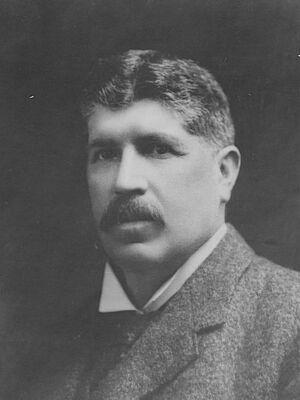John Murray (Victorian politician) facts for kids
Quick facts for kids
John Murray
|
|
|---|---|
 |
|
| 23rd Premier of Victoria | |
| In office 8 January 1909 – 18 May 1912 |
|
| Preceded by | Thomas Bent |
| Succeeded by | William Watt |
| Personal details | |
| Born | 8 July 1851 Koroit, Victoria, British Empire |
| Died | 4 May 1916 (aged 64) Warrnambool, Victoria, Australia |
| Nationality | Australian |
| Spouse | Alice Bateman |
John (Jack) Murray (born 8 July 1851 – died 4 May 1916) was an important Australian politician. He served as the 23rd Premier of Victoria, leading the state government from 1909 to 1912.
Contents
Early Life and Family
John Murray was born near Koroit, Victoria, in 1851. His parents, James and Isabella Murray, were immigrants from Scotland. When John was a child, his family moved to a farm called Glenample station near Port Campbell in the Western District of Victoria.
He went to Allansford National School and later attended Henry Kemmis's Warrnambool Grammar School starting in 1868. Around the age of 20, John Murray visited Britain. He was very concerned by the poverty he saw there, but he returned to Victoria. He later inherited the family farm and lived there for his whole life.
On 4 April 1888, John Murray married Alice Jane Bateman in Warrnambool. Together, they had six children.
Start in Politics
John Murray first tried to enter politics in 1883. He ran for the Warrnambool seat in the Victorian Legislative Assembly but was not successful. However, the politician holding the seat, James Francis, passed away in 1884.
Murray then won the vacant seat and continued to represent Warrnambool for 32 years, until his death. He was known for being a strong speaker and a good leader in parliament.
Political Career and Leadership
John Murray was a typical country conservative politician. He held several important roles in the Victorian government. From 1902 to 1904, he was the Chief Secretary and Minister for Labour in the government led by William Irvine.
Later, from 1904 to 1906, he served as the President of the Board of Land and Works and Commissioner of Crown Lands under Premier Thomas Bent. After 1907, Murray became a leader for a group of country politicians within Bent's Liberal Party. This group disagreed with Bent's policies, especially his high spending.
In January 1909, John Murray successfully led a vote of no-confidence against Bent's government. This meant that the parliament no longer supported Bent. As a result, Murray became the new Premier of Victoria. He also took on the roles of Chief Secretary and Minister for Labour.
Premier of Victoria
As Premier, John Murray also served as the formal chairman of the Board for the Protection of Aborigines starting in 1909.
Even though the Labor Party won the federal elections in 1910, they were not as strong in Victoria. In the 1911 state elections, Murray's Liberal Party was re-elected. They won 43 seats, while Labor won 20.
However, there were ongoing disagreements within the Liberal Party between politicians from rural areas and those from cities. The urban leader, William Watt, challenged Murray's leadership. By May 1912, John Murray decided to resign as Premier.
Later Years and Legacy
After resigning as Premier, John Murray continued to serve in government. He accepted the role of Chief Secretary in William Watt's government from 1912 to 1913, and again from 1913 to 1915.
John Murray passed away in Warrnambool on 4 May 1916. He was known as a physically large man with a good nature. He was well-read and an excellent speaker who often used humor and clever remarks. He was a skilled administrator and a good leader in parliament, known for handling difficult situations with tact and success.
Images for kids


